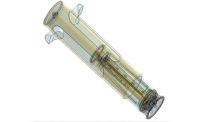In the late 19th century, Swiss craftsmen Jules Louis Audemars and Edward Auguste Piguet met at Vallee de Joux and started working together in watch manufacturing. Audemars started producing component parts for movements and Piguet was the repasseur, the person who made the final regulation of the timepiece.
In 1875, they founded a firm later known as Audemars, Piguet et Cie SA. For more than 130 years, the company has been developing and crafting precision watches.
These timepieces feature a large number of flexible high-precision components that work together in a small but highly accurate moving assembly. They also feature complex mechanisms that require detailed design and manufacturing, and precision to within 0.001 millimeter.
One critical component is the date display mechanism that changes the date exactly every 24 hours. The mechanism must reveal the correct next date and advance the date in a way that appears instantaneous to the human eye (usually within 0.015 second). It uses a jumper, spring and trigger cam to rotate the display disk exactly one date step.
Traditionally, each mechanism is designed using prototyping, which is a costly and iterative process. In 2012, Audemars, Piguet decided to try a different approach: Use Anasys Inc. software to simulate an optimum working mechanism and use that as a model for a real mechanism.
Watch designers open Anasys Mechanical software and import the mechanism geometry. This software automatically detects and performs setup for contacts or joints between parts of the mechanism. Contact settings and options can be modified, and additional manual contact definitions can be added.
Next, the designers use Anasys LS-DYNA software to precisely analyze the transient dynamics of the simulated mechanism. The software then compares the performance data of the simulated mechanism with that of an actual mechanism. Because watch production cannot proceed until the two sets of data match, using simulation helps Audemars Piguet designers create mechanism components that are precise, flexible and meet all performance criteria.
“When designing luxury watches, precision is vital,” says Tiavina Niaritsiry, head of numerical and optimization engineering for Audemars Piguet. “The software provides the accuracy required to design a watch to our exacting specifications. This reduces the need for costly prototypes and helps us reduce development time by half.”
LS-DYNA’s analysis capabilities include quasi-static simulations, two- and three-dimensional graphics, normal modes, linear statics, crack propagation, and thermal and fluid analysis. Its material library includes metals, plastics, glass, foams, fabrics, elastomers, honeycombs, viscous fluids and user-defined materials.
For more information on simulation software, call 866-267-9724 or visit www.ansys.com.
Simulation Software Quickens Product Development for Watchmaker

Since 1875, Audemars, Piguet et Cie SA has developed and crafted precision watches and timepieces equipped with complex mechanisms. Photo courtesy Audemars, Piguet et Cie SA

